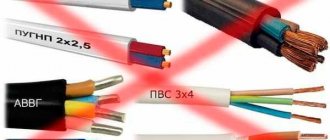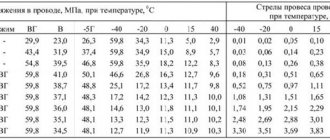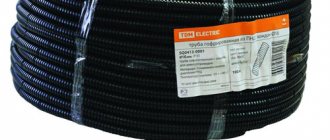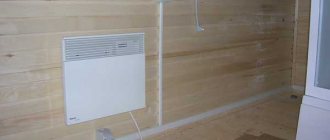Diagram to help!
It is best and most accurate to carry out the calculation by first drawing up a diagram of the electrical wiring in the house.
The prepared project must indicate the following points:
- The exact number of sockets, switches and distribution boxes, as well as the height of their mounting and the method of connection to the network (through distribution boxes in the rooms or directly from the panel). Read more about the location of sockets in the apartment in the article: https://samelectrik.ru/pravilnoe-raspolozhenie-rozetok-v-kvartire.html.
- Installation locations for all lighting fixtures in the rooms: sconces, chandeliers and, most importantly, spotlights. By the way, before calculating the length of the cable for the electrical wiring, decide on the height of the ceiling. You must understand that the margin will be about 20 cm if the ceilings do not drop, and about 50 cm if the ceiling drops by 30 cm.
- The selected cable cross-section for the socket group, connecting powerful electrical appliances and lighting lines. For example, when designing lighting, wires with a cross-section of 3 * 1.5 mm2 are usually used, while sockets require a cable with more powerful conductors - 3 * 2.5 mm2. As for powerful electrical appliances, even to connect the hob, a cable with a cross section of 3 * 6 mm2 must be used (according to SP 256.1325800.2016 clause 10.2). As you understand, this is a very important point when calculating the length of the wiring, because... You will have to buy each type of wire separately in the required quantity. You can calculate the cable cross-section for power and current without any problems.
By the way, you also need to decide right away about connecting household appliances. Most likely, each group of electrical appliances will have to have a separate wire from the panel, and not just a new line from the distribution box in the room!
Having already prepared a visual wiring project, you can calculate how much cable is needed to supply electricity to a house or apartment. Of course, it would be ideal to immediately mark the walls and ceiling for wiring, and then simply use a tape measure to measure all the drawn lines and calculate the total number of each type of wire for the designed network, but, as practice shows, no one does this.
Additionally, you must make the following adjustments to the calculation that you may not have known about:
- Multiply the total number of wires by a factor of 1.1-1.2. This is a reserve that will not allow a situation where there are several meters short of the sockets and you have to go buy more material.
- For sockets and switches, leave a margin of at least 20 cm for connecting electrical wires.
- If you have not decided on the ceiling, it is better to calculate the reserve of at least 50 cm of cable for connecting the lamps.
- To assemble the distribution panel, the margin should be about 50 cm.
Using this principle, you can independently calculate the amount of materials for installing electrical wiring in a house or apartment. We will talk about a simpler calculation technology below.
Electrical wiring calculation: where to start
First, we measure and calculate everything. The resulting figures should be multiplied by 1.15 or 15%. This is a standard margin for technical calculations.
If you cannot measure everything and you need to know “at least approximately,” then you can use a simple approximation: the area of the premises (in square meters) is multiplied by 2! That is, for a standard two-room apartment with a total area of 50-53 m2, about 100 m of cable will be required. No matter how scary it sounds. And if a designer enters the fray, then get ready to multiply by 3, and sometimes by 5. Usually he will calculate everything himself and “delight” you.
What if multiple types of wires are used? Unfortunately, there is a risk here. Try taking it at a 1:2 ratio. One part for , two parts for power supply. If you need to lay a separate cable to a washing machine, air conditioner or electric stove, you will have to measure the lengths along a specific path.
There is no need to immediately take the automatic switches into the car. These things are purchased for specific tasks and their quantity, as a rule, is always known. Just buy a moderately capacious electrical panel to increase the range as needed. For example, if you bought a regular one for one place, then if you wish, you can install a differential one for 2 places or an RCD.
It’s impossible to take into account and provide for everything, but you can try.
Everything is to the maximum here.
Number of energy consumption points (sockets, switches and lamps):
In the kitchen - twin sockets in all four corners plus 2 sockets for 4-5 sockets in the work area for stoves, juicers, food processors, electric kettles, etc. In the bathroom - 2 sockets (or 1 paired) for a washing machine, hair dryer, electric razor, etc. The rooms have twin sockets in all four corners and 2-3 more sockets for fumigators, night lights, and recharging various gadgets. Switches are installed at the rate of 1 switch per room, but if you have an apartment on two levels, therefore, with a staircase, or there are 2 doors in the room and you want to place a switch near each, then you will need special switches and additional electrical wiring. The number of lamps on the ceiling and on the walls depends on your imagination, but at least 1 per room (less does not make sense).
Length :
Calculate the total length of the wires according to the plan and multiply the result by 1.2. 1.2 is a correction factor that takes into account the additional wire consumption during electrical work and possible errors in calculations. There is a simpler, but less accurate method: multiply the area of the apartment by 3. For example, for a standard 2-room apartment with an area of 50 m2, 150 meters of wires are required.
Wire type:
It is better to use two-core copper wire with stranded strands. If you use a plastic corrugated sleeve when laying wires, then it is enough to buy wires with regular insulation. In all other cases, it is better to use double-insulated wires, or, scientifically speaking, electrical cables. However, if you have a two- or three-core aluminum wire with cast cores of Soviet production in your stash, you can use it, as long as the rats don’t eat through the insulation and there is enough cross-section for your needs.
Section:
It all depends on what your maximum load will be. In the standard version, the main energy consumers are an automatic washing machine (power up to 2.2 kilowatts, current up to 10 amperes) and an electric kettle (power up to 2.2 kilowatts, current up to 10 amperes), other standard electrical appliances (food processors, vacuum cleaners , computers, televisions, lighting) can add up to 3 kilowatts, but if you use probability theory, you get 1 kilowatt. In total - 5.4 kilowatts or 24 Amperes. This means that for the main wiring you will need a standard cable with a core cross-section of 2.5 mm. For lighting (wires from the room junction box to the lamp, between lamps and from the box to the switch), a cable with a cross-section of 0.5 - 0.75 mm 2 is sufficient. Electric stoves with ovens consume up to 10 kilowatts. Air conditioners will add 0.1 kilowatt per m2. Warm floors - 0.2 kilowatts per m2. So do the math, and you can determine the cross-section you need using the table:
Option for the lazy
If you are too lazy to spend time designing your home network, you can use a simplified calculation of the length of conductors. This method, by the way, is used by many even professional electricians who, from their own experience, can calculate how much wire is needed for a particular object. The bottom line is that you need to calculate the amount of cable for electrical wiring based on the area of the room. It’s all very simple – take the area of a private house or apartment and multiply by “2”. This is approximately the length of cable products you need to carry out the wiring.
In addition to the fact that this is a “calculation by eye,” you should not forget about an important nuance - thus, you can only calculate the length of one of the lines (lighting or power). But you won’t be able to find out exactly how much wire you will need for sockets and how much for lighting.
In this case, again, it is customary to take products in a ratio of 1:1.5 - 1 part for providing light in the rooms, and 1.5 parts for sockets and connecting equipment. For example, if a house has an area of 100 sq.m., you will have to buy 200 meters for lamps and 300 for sockets.
Based on reviews from many forum users, including electricians, we can say that this option for calculating electrical wiring in most cases turns out to be correct. People write that, for example, for a one-room apartment with an area of 40 sq.m. 100 meters of cable was enough. At the same time, to supply electricity to a two-story cottage with a total area of 400 sq.m. it is enough to calculate 1 km of each type of wire. If the calculation is incorrect, it is better to buy a few tens of meters in addition than to overpay a fairly decent amount.
Finally, we recommend watching a video that outlines the calculation of the amount of materials for electrical installation:
This is how you can find out how much wire you need to power your home. By the way, if you decide to make open wiring, you need to calculate the length of the cable channels only based on the finished diagram. We hope that now you know how to calculate the amount of cable for electrical wiring.
Also read:
- Typical wiring diagram for a 3-room apartment
- Calculator for calculating cable cross-section
- How to calculate the number of spotlights
How many sockets can be connected to one 2.5 wire?
The fact that electrical wiring for sockets in apartments or houses should be done with a VVGng-LS cable with a core cross-section of 2.5 mm2. is known to many, but besides this, other questions often arise; one of the most common ones asked to me is “How many sockets can you connect to one 2.5 wire?”
You can hang almost as many electrical outlets on such a cable as you want, and this is no joke. This is because the sockets themselves do not consume electricity and are essentially the same conductor as an electrical cable, therefore they themselves do not have any significant impact on the network.
The choice of the number of sockets that you could connect with one cable with 2.5 mm2 conductors depends only on the power consumption of the devices that will be included in these sockets.
Any wire, depending on the material of manufacture, cross-section, as well as some other characteristics, has its own limitations on the maximum transmitted current and power.
Therefore, if you turn on devices in several sockets connected to one cable, the total power consumption is higher than the threshold value for this cable, the conductor will begin to heat up and collapse.
This often causes a fire.
So, for example, a cable made in accordance with GOST, having a fair cross-section of copper conductors of 2.5 mm.kv, on average, can withstand a current of 25-27 Amperes for a long time, which, roughly speaking, is equal to a power of 5.5-5.9 kW.
These values are taken for standard living conditions; they may vary depending on the length of the route and the installation method, but usually, when designing the electrical wiring of an apartment or small private house, you can rely on these indicators.
No matter how many sockets you install on one wire with a cross-section of 2.5 mm2, they will only withstand electrical appliances with a total power of no more than 5500 W - 5900 W. If you need more power, I recommend dividing the outlets into two or more groups, each of which is connected with its own cable.
To protect the cable from destruction when turning on too energy-intensive electrical appliances, it is customary to install a circuit breaker (AB, automatic). For cable with a cross section of 2.5 mm2.
, for a number of reasons, a circuit breaker with a rating of 16A is installed, which corresponds to approximately 3.5 kW of power.
Thus, when creating safe electrical wiring, the number of sockets in each group is calculated precisely according to this indicator - no more than 3.5 kW of simultaneous load on each socket group.
Let me give you a few examples to make it clearer:
An electric kitchen oven is most often supplied with a standard electrical plug, which is plugged into a 220 V single-phase outlet. In this case, the oven power is often close to 3.5 kW. Accordingly, in the electrical line with a cable cross-section of 2.5 mm2, to which the oven will be connected, you can safely install only one socket.
At the same time, all sockets, for example, in the living room, bedroom and children's rooms, in an ordinary three-room apartment, of which there are 15-20 in total, can also be connected all with one cable. Since the power of all electrical appliances used in these premises often does not exceed 3.5 kW.
It should be noted that the most energy-intensive electrical appliances are most often located in the kitchen and bathroom; these are basically any devices that heat something (electric kettle, oven, washing machine, hair dryer, etc.). Therefore, it is especially necessary to carefully calculate the number of sockets on one cable, precisely in these rooms.
There are a number of methods for dividing sockets into groups, which take into account, in particular, the power of the connected equipment, and in addition a number of other characteristics that make the operation of apartment sockets convenient and safe. I'll tell you about them next time.
OUTPUT: Number of sockets that can be connected to one 2.5 mm2 cable. depends mainly on the power consumption of the electrical equipment included in them, there are no other restrictions.
It is best to calculate the number of outlets in such a way that the power of electrical appliances simultaneously connected to them does not exceed 3.5 kW. When designing electrical wiring, this can be calculated quite accurately, knowing where and what equipment will be located and in what mode it will operate.
Cable cross-section
Before choosing a cable, you need to calculate the power consumption. The cable cross-section directly depends on this factor.
So, let's say that we have the following appliances in our kitchen:
— electric kettle 2.0 kW
— microwave oven 0.7 kW;
— refrigerator 0.7 kW;
2.0 + 0.7 + 0.7 = 3.4 kW
Consumption in the kitchen was 3.4 kW.
To convert to watts, you need to multiply by 1000: 3.4 kW * 1000 = 3400 W.
To find the current strength, we convert it into amperes using the formula: power divided by voltage (P / U = I) 3400 / 250 = 13.6.
The current strength is 13.6A.
Now it is necessary to take into account the demand coefficient, it takes into account the number of electrical appliances, in our case there are 3 of them, the coefficient values are as follows:
2 electrical appliances – 0.8
3 electrical appliances – 0.75
5 or more electrical appliances – 0.7
And so our coefficient is 0.7. Multiply by the resulting current: 13.6 * 0.7 = 9.52 A
Thus, the operating current in the kitchen was 9.52 amperes.
Knowing the operating current, we can safely select the machine and wires. You need to select them with a small gap. So a machine with a working current of 10A is suitable for us.
The cable is selected in accordance with the table of rules for electrical installations, the table is given below.
| Wire cross-section in mm² | Maximum permissible current for copper (A) | Maximum permissible current for aluminum (A) |
| 0,75 | 11 | 8 |
| 1,0 | 15 | 11 |
| 1,5 | 17 | 13 |
| 2,5 | 25 | 19 |
| 4,0 | 35 | 28 |
| 6,0 | 42 | 32 |
| 10,0 | 60 | 47 |
| 16,0 | 80 | 60 |
Based on the table, a copper cable with a cross section of 0.75 mm² is suitable for us
As mentioned above, the cable must be selected with a small gap, this is necessary to avoid overheating of the wires.
Also, when choosing a cable, the environment in which it will be used, as well as the operating conditions, plays an important role. For example, in rooms where flammable materials are stored (garage, warehouse, etc.) a cable with a non-flammable winding is used. In apartments, the cables most often used are PBPP, PVS - flexible, with multi-wire cores, or VVGng and VVG - rigid, with a single-wire core.
It is also not difficult to calculate the required cable length. This is why we initially asked to carry out the apartment plan taking into account the scale. The only caveat is that you need to add 15% to the resulting length - this is the standard margin.
How to calculate power consumption
You can calculate the approximate cable cross-section yourself - it is not necessary to seek the help of a qualified specialist.
The data obtained as a result of the calculations can be used to purchase wires, however, the electrical installation work itself should be trusted only to an experienced person. The sequence of actions when calculating the section is as follows:
- A detailed list of all electrical appliances in the room is compiled.
- The passport data of the power consumption of all found devices is established, after which the continuity of operation of a particular equipment is determined.
- Having identified the value of power consumption from devices that operate constantly, you should sum this value by adding to it a coefficient equal to the value of electrical appliances that turn on periodically (that is, if the device will work only 30% of the time, then you should add a third of its power).
- Next, we look for the obtained values in a special table for calculating the wire cross-section. For greater guarantee, it is recommended to add 10-15% to the obtained power consumption value.
To determine the necessary calculations for selecting the cross-section of electrical wiring cables according to their power within the network, it is important to use data on the amount of electrical energy consumed by devices and current appliances. At this stage, it is necessary to take into account a very important point - the data of electrically consumed devices does not give an exact, but an approximate, average value
Therefore, to this mark it is necessary to add about 5% of the parameters specified by the equipment manufacturer
At this stage, it is necessary to take into account a very important point - the data of electrically consumed devices does not give an exact, but an approximate, average value. Therefore, about 5% of the parameters specified by the equipment manufacturer must be added to this mark.
The majority of not the most competent and qualified electricians are confident in one simple truth - in order to correctly install electrical wires for lighting sources (for example, for lamps), it is necessary to take wires with a cross-section equal to 0.5 mm², for chandeliers - 1, 5 mm², and for sockets – 2.5 mm².
Only incompetent electricians think about this and think so. But what if, for example, a microwave, kettle, refrigerator and lighting operate simultaneously in the same room, which require wires with different cross-sections? This can lead to a variety of situations: short circuit, rapid damage to wiring and insulating layer, as well as fire (this is a rare case, but still possible).
Exactly the same not very pleasant situation can happen if a person connects a multicooker, a coffee maker and, say, a washing machine to the same outlet.
How to determine the cross section in practice
The method for calculating the conductor cross-section in practice involves two stages:
- Calculation of the total power of all electricity consumers in the house using the formula: P = (P1+P2…+…Pn)×K×J, where P1+…+Pn is the power of each electrical appliance, K is a coefficient (dimensionless) indicating the percentage of equipment involved (of the total number of cash in the house), J – power reserve factor (usually J = 1.5... 2).
- Determination of the section from the table.
In the above formula, the coefficients are determined through practical research. In particular, K usually does not exceed 0.8 (80%). This means that the equipment in the house is not used at the same time. In fact, you wouldn’t turn on the air conditioner and heating device at the same time.
The power reserve (J) also needs to be taken into account for the future. After all, energy consumption is growing every year. If growth is not taken into account, then after a few years reinforcement of the wiring may be required.
Having calculated the total power of all consumers using the formula, it is easy to determine the required wiring cross-section from the table.
Method for determining the cross-section of home wiring
When calculating the cross-section of an electrical cable when installing home wiring, many factors are taken into account. There are special computer programs that allow you to take into account all the features of the house and the needs of its residents. But you can determine the cross-section required for wiring yourself using the described method.
It is important to understand that the diameter of the wires in the apartment may differ from room to room. At the entrance to the electric meter there is only one; at the distribution box the wire cross-section may already be smaller, at sockets and lamps - even smaller.
At each section of electrical wiring, it is advisable to determine the parameters necessary for it, so as not to overpay for excessively thick wires.
If you do not want to calculate the cross-section of the wiring being laid, you can use the recommendations of experienced electricians who claim:
Despite the recommendations of PUE 7.1.34 to carry out calculations for all power lines, practical experience shows that in most cases standard values can be accepted. As a rule, lighting branches in apartments and houses are laid with 3x1.5mm² cable. The maximum power is 4.1 kW. The machine is installed on the lighting branches with a nominal value of 10A. Power supply lines for plug sockets are laid with 3x2.5mm² cable. The maximum power is within 5.9 kW, a circuit breaker with a rating of 16A is needed. To ensure the connection of powerful consumers, such as an electric stove, oven or MKCh, a 3×6mm² cable is used. Maximum power up to 10.1 kW. A machine is needed with a rating of 32 A. To enter the electrical network into a house or apartment, use a cable with a cross section of 3×6mm². However, now, due to the increase in powerful consumers in housing, cables with a cross-section of 3×10mm² are increasingly used for input. The most suitable cable for home wiring is VVGng-LS. It contains a slight inclusion of halogens, which create a hazard when smoldering. Cables marked VVG and VVGng are prohibited for installing an electrical network in a house or apartment. Their insulation is made of PVC, a polymer that releases a large amount of toxic substances when burning/smoldering. It is prohibited to construct electrical wiring from PVC-insulated cable due to the significant halogen content. Smoldering wire insulation with low content allows people to evacuate without getting seriously poisoned. The PPGng-HF cable is considered the safest for the life and health of residential property owners. Its insulation contains no halogens at all.
Types of wires
In the case of the wire brand, the best solution would be the PVS or KG option. The first type stands for vinyl connecting wire. This product has copper conductors, each of which is protected by insulation and all of which are contained in a white sheath. Such a power wire can withstand voltages up to 450 V, and the insulating material does not burn, which allows the wire in question to be heat-resistant.
It is also characterized by high strength and excellent bending resistance. It can even be used in unheated and damp buildings, where it will last 6–10 years, depending on operating conditions. Excellent for connecting electric stoves.
If we talk about wire type KG, then its name stands for flexible cable. Its shell is made of a special type of rubber. In addition, the same sheath protects tinned copper conductors. Between the wires there is a special film that performs a protective function. It must prevent the wires from sticking together due to heat from use.
Typically, a KG wire contains from 1 to 5 cores. As you can understand, the core cross-section determines the power that the cable can withstand. This cable is operated in the temperature range from -40 to +50 degrees. The KG cable can withstand voltages up to 660 V. Typically, this wire has the following designation: KG 3x5+1x4. This means that there are 3-phase conductors with a cross-section of 5 square meters. mm, and one grounding conductor with a cross section of 4 sq. mm.
Regardless of which wire will be selected to connect the electric stove, it should be purchased with a reserve length so that the product can be moved. In addition, the wiring running inside the room and at the entrance to the apartment must be of high quality, which should also be checked before starting the connection.
Voltage drop calculation
Not only the degree of heating of the core, but also the electrical voltage at the far end of the wire depends on the cross-section of the electrical cable. Household appliances are designed for certain parameters of the electrical network, and their constant discrepancy can lead to a reduction in the service life of the equipment.
If the voltage drops on the boiler, it is advisable to install a stabilizer so that the equipment does not experience additional loads due to inconsistencies in the operational characteristics of the electrical network.
As the cable lengthens, a voltage drop occurs. This effect can be reduced by increasing the wire cross-section. It is considered critical to reduce the voltage at the end of the wire by 5% compared to its value at the current source.
This indicator can be calculated using the well-known formula:
Upad = I*2*(ρ*L)/S,
Where:
- ρ – metal resistivity, Ohm*mm2/m;
- L – cable length, m;
- S – conductor cross-section in mm2;
- Upad – drop voltage, Volt;
- I – current flowing through the conductor.
If the calculated voltage drop is more than 5% of the rated voltage, then it is necessary to use a cable with a larger cross-section. This will ensure stable operation of the equipment.
Heating boilers, washing machines and other devices with many relays and sensors are especially sensitive to voltage values. This feature must also be taken into account when using carriers.
The length of the main power cable in a high-rise building is how many meters in a 10-story building
Calculating the length and cross-section of the main power cable in a multi-story building may be necessary when repairing electrical wiring. Thus, residents of old apartments often change the wiring in favor of a more powerful one. At the same time, the voltage on the power cable increases. Because of this, the cable heats up and becomes unusable. A reasonable question arises about replacing the main power cable in the entrance with a cable with a larger cross-section. The main problems that residents may encounter are obtaining permission from the utilities of the housing department or homeowners association, the queue for the repair team to fulfill the application, and the cost of the cable itself.
Since the main cable runs only from the ASU to the top floor, calculating its length will not be difficult: it will be equal to the height of the house, taking into account the necessary technological clearances.
For a ten-story building, the cable length will be about 35 meters. But all these preliminary calculations can only be used to calculate the estimated cost of the cable. The exact length and cross-section should only be obtained from employees of the relevant utility company to which your home belongs.
How to calculate electrical wiring on a site
In the local area, along the paths, sometimes even in the garden and flower bed, as well as along the perimeter of the site, there is always some kind of lighting. And if some particularly economical owners find it more convenient to use solar-powered lanterns and decorative lamps, then traditionally power lines from the nearest substation are stretched to the land plots. This can be an overhead cable or underground; in the first case, it passes through insulators on the tops of the poles, and in the second, through a special dielectric pipe buried deep in the ground.
Based on how electricity is supplied, it is necessary to calculate the continuation of the line on the site. The simplest solution is from two wires, one of which is phase and the other neutral, sometimes a house may have three wires to provide two separate phases. A four-wire input is necessary if there is a need for a three-phase version, if there is an appropriate consumer (industrial and professional equipment, machine tool). The latter type of connection can only be used after obtaining permission from the electricity supply organization.
So, let's focus on a single-phase two-wire connection to the substation, which still needs to be extended if you do not want to pay for the work of specialists. Before calculating the electrical wiring, you should take into account that the length of the cable from the common line to your site should not exceed 25 meters; at a greater distance (and in case of strong winds in your area and at a shorter distance) you need to install a support. The height of the cable above the road is at least 6 meters; it is advisable to install an overhead line into the house at a level of 3 meters.
At the output from the substation where the transformer is located, the current usually already has a voltage of 220 V. But drops in the electrical network are common, and it may turn out that some 160 V is coming to you. To obtain the required voltage level, you need to install a stabilizer, as well as circuit breakers that will protect the network from overload. Their parameters are indicated in Amperes, that is, they are measured against current consumption. Having completed the distribution panel, we place it in a place where there is no dampness.
Wires are extended to all outbuildings, be it a barn or a summer shed; this can be done by air or directly, which will be more economical. It is better to provide lighting along the paths with an underground cable, and the lights should be connected in parallel rather than in series, so that the burnout of one lamp does not turn off the entire circuit. We take a plan, and on it we mark the overhead line connecting the buildings with the distributor, and the underground cable stretching from it along the paths (and repeating all their bends). We measure the resulting wiring and multiply its length by 2, since at least two wires are needed (double insulation is recommended outdoors), for phase and zero.
How to calculate the parameters of the required cable
If the power line is of impressive length (100 meters or more), then all calculations must be made taking into account the current losses that will occur directly on the cable. This is done without fail when designing the electrical supply of houses. All initial data is entered into the project in advance, for control and reinsurance they are double-checked using the power norm allocated for the entire house and the length from it to the pole. The following table helps you calculate the required parameters:
It is better to select a suitable wire cross-section when installing electrical wiring with a margin. If it is, all new devices that appear in the apartment can be safely turned on without fear of overload.
If the cross-section is not enough, then there are only two options: replacing the wiring or refusing to simultaneously use powerful home appliances.
If you urgently need to extend the socket, but the required wire is not nearby, you can use different cables, connecting them parallel to each other. This method is not used constantly, but is resorted to in moments of extreme necessity, but if it is used, and even more so to connect a powerful device, then you need to use wires of the same cross-section
If this requirement cannot be met, then when calculating whether the wire will withstand, you need to take into account only the cable of a smaller cross-section
Calculation of wiring outside the home
If you live in a private house, you have probably thought more than once about how you can decorate your garden space. One option is to install outdoor lighting fixtures. Some people use flashlights with solar panels, while others run electrical lines. The wire can be laid either deep underground, using dielectric pipes, or above it.
There are several types of connection:
- single-phase;
- two-phase;
- three-phase.
Electrical wiring on the site directly depends on the type of supply from the house. In most cases, a two-wire system is sufficient for minimal electricity consumption. One will be a phase, the other will be a zero. There are situations when three wires are needed to connect the cable from the house to the site. The third plays the role of the second phase. If you have a power source on your site, such as a transformer or machine, you will need to use a three-phase wiring method. Such a four-wire input is permissible only after the appropriate permission from the organization that supplies you with electricity.
Let's consider a single-phase two-wire connection on a house site.
First, let's give a few recommendations:
- Before starting calculations, it is necessary to take into account the length of the cable. If the distance from the source to the site exceeds 25 meters, then it will be necessary to erect additional fastening for the wire. If your area experiences significant winds, then this distance should be reduced to 15–20 meters;
- if the cable passes over the roadway, its height must be at least 6 meters above the ground;
- It is recommended to connect the line to the house at a height of at least 3 meters.
As you know, current leaves the transformer at a voltage of 220 V. But there are situations when voltage drops occur, and much less can reach you - about 150 V. Stabilizers are created for this. They are installed where electricity comes out. Also equip the system with network overload protection circuit breakers. The distribution panel must be located in a dry place.
You can lay the wire both underground and directly through the air. The latter option will be much more economical. In the case of lanterns along paths, it is better to get by with underground cable laying. Light bulbs must be connected in a parallel circuit. This way you will exclude the possibility of the lack of all lighting as a result of one of them burning out.
To perform a wire calculation, take a site plan and mark all underground and overhead electrical transmission lines. Sum up their lengths and multiply by two. This is necessary because you will need two wires.
Marking
Determine at what height the sockets and switches will be located; the easiest way is to measure the lines of sockets and switches from the ceiling, because the floors in apartments are most often crooked. For example, if the height from floor to ceiling after renovation will be 250 cm, and you want to raise the sockets by 30 cm, measure 220 cm from the ceiling. If there are several sockets and switches in one group, draw a horizontal line along the level and place a mark every 7 cm (socket box size 71mm), the same applies to vertical groups.
For lovers of standards, so that it is “like everyone else” or “how they do it” - remember, they do not exist! There are requirements for children's institutions, kindergartens and schools, where sockets and switches are installed at a height of at least 160 cm. Everything else, especially in your home, you can do as you wish. For example, some make sockets in window slopes or even in the floor.
Calculation of electrical wiring in the apartment
First of all, you need to remember that the calculation of electrical wiring in an apartment begins with drawing up a wiring diagram.
If you decide to do the wiring yourself, you need to pay special attention to the following issues:
- determination of the cross-section of wire cores;
- under what conditions the wire will be laid;
- how to connect the meter;
- grounding;
- total power of devices;
- power grid protection.
An average one-room apartment requires a total power of 15 kW. It is more convenient to calculate power consumption if you conditionally divide the wiring into several groups.
For example, sockets for:
- bathroom;
- rooms;
- kitchens;
- corridor.
And separately take into account the lighting of the apartment. This will make it easier for you to calculate the maximum load of electrical appliances in your home. If in doubt, use a special calculator that you can find on the Internet in construction forums.
Also, when calculating the wiring, try to determine as accurately as possible the total power consumed by all large electrical appliances in the apartment. To do this, you will need the information that the manufacturer provides in the instruction manual or on the boxes. You can also find additional information on the Internet.
As you can see, you can calculate the electrical wiring yourself. Remember to be precise in any calculations. If you have encountered such calculations, please share your comments under this article.
Selection of circuit breaker rating for current and load power
To select a suitable machine, it is convenient to calculate the current per kilowatt of load power and draw up the corresponding table. Applying formula (2) and a power factor of 0.95 for a voltage of 220 V, we obtain:
1000 W / (220 V x 0.95) = 4.78 A
Considering that the voltage in our electrical networks often does not reach the required 220 V, it is quite correct to take the value of 5 A per 1 kW of power. Then the table of current versus load will look like this in Table 1:
| power, kWt | 2 | 4 | 6 | 8 | 10 | 12 | 14 | 16 |
| Current strength, A | 10 | 20 | 30 | 40 | 50 | 60 | 70 | 80 |
This table gives an approximate estimate of the strength of alternating current flowing through a single-phase electrical network when household electrical appliances are turned on. It should be remembered that this refers to peak power consumption, not average. This information can be found in the documentation supplied with the electrical product. In practice, it is more convenient to use the table of maximum loads, which takes into account the fact that machines are produced with a certain current rating (Table 2):
| Connection diagram | Current ratings of automatic machines | |||||||
| 10 A | 16 A | 20 A | 25 A | 32 A | 40 A | 50 A | 63 A | |
| Single-phase, 220 V | 2.2 kW | 3.5 kW | 4.4 kW | 5.5 kW | 7.0 kW | 8.8 kW | 11 kW | 14 kW |
| Three-phase, 380 V | 6.6 kW | 10,6 | 13,2 | 16,5 | 21,0 | 26,4 | 33,1 | 41,6 |
For example, if you need to find out how many amperes a machine needs for a power of 15 kW with a three-phase current, then we look in the table for the nearest larger value - it is 16.5 kW, which corresponds to a machine with a capacity of 25 amperes.
In reality, there are limitations on the allocated power. In particular, in modern urban apartment buildings with an electric stove, the allocated power is from 10 to 12 kilowatts, and a 50 A automatic machine is installed at the entrance. It is reasonable to divide this power into groups, taking into account the fact that the most energy-intensive appliances are concentrated in the kitchen and bathroom. Each group is equipped with its own machine, which eliminates the complete loss of power to the apartment in the event of an overload on one of the lines.
In particular, under an electric stove (or hob) it is advisable to make a separate input and install a 32 or 40 ampere machine (depending on the power of the stove and oven), as well as a power outlet with the corresponding rated current. You should not connect other consumers to this group. Both the washing machine and the air conditioner should have a separate line - a 25 A machine will be sufficient for them.
The question of how many sockets can be connected to one machine can be answered in one phrase: as many as you like. The sockets themselves do not consume electricity, that is, they do not create a load on the network. You just need to make sure that the total power of simultaneously switched on electrical appliances corresponds to the cross-section of the wire and the power of the machine, which will be discussed below.
For a private house or cottage, the input machine is selected depending on the allocated power. Not all owners are able to obtain the desired number of kilowatts, especially in regions with limited power grid capabilities. But in any case, as for city apartments, the principle of dividing consumers into separate groups remains.
Introductory machine for a private home
Installing a ground loop
Any private house must be equipped with a grounding loop, which performs several tasks:
- Protects the inhabitants of the house when voltage appears on the device body.
- Supports the safe operation of appliances operating in a damp environment (washing machines and dishwashers, electric stoves, boilers and instantaneous water heaters).
- Reduces the level of noise (interference) in the electrical network.
The circuit is installed in the ground next to the house; Inside, the grounding is connected to the electrical panel. It is required for:
- high power electrical engineering;
- light sources (circuit groups) in bathrooms.
Installation of distribution board
Installation and switching of cables and structures
Electrical wiring in the house is connected to each other using the following method:
- Soldering. Soldering is not used for in-house installation; it is an expensive and labor-intensive process.
- Twisting. The easiest way to install wires from the same material. Copper and aluminum cannot be twisted - the connection will heat up.
- Connections on terminal blocks. Reliable, simple and inexpensive installation method. Terminal blocks of various types, shapes, types and sizes greatly simplify installation.
Installation of distribution board elements
After the electrical connection diagram for a private home has been selected and consumers have been divided into groups, a distribution board is installed. It contains:
- circuit breaker and RCD – general;
- automatic machines and RCDs – for designated groups;
- counter;
- zero bus and main ground bus.
On a panel, the function of a core can be determined by the color of its insulation:
- white (sometimes red, black or brown) corresponds to phase;
- blue – zero;
- yellow-green – protective grounding.
The final distribution board for electrical wiring in a private house is assembled after the installation of the wiring is completed.
Applicable wire colors
Installation of electrical wiring of closed and open type
Wiring in a new house is installed in two ways - open and closed, and the first option is often chosen when it is impossible to use the second.
- Open wiring. It is laid over the walls and, if desired, protected by cable ducts. It has its advantages - it is always available for inspection. At the same time, like any technical element in the interior, it “hurts the eye.” The exception is the design of premises in a loft or retro style, where such solutions are welcome.
In open installation, the cable is fastened with staples to the surface, then it is covered with a box. Recesses for sockets and switches are made with a hammer drill or drill.
Box (cable channel) for open wiring
- Hidden wiring. With hidden installation, you have to groove the walls (punch through channels), lay wires and hide them behind the wall trim. This method is more reliable and durable, but at the same time labor-intensive and costly for future alterations. To avoid touching cables in the future when drilling into walls, it is worth stocking up on a network layout plan.
Electrical wiring in the house is done according to the same rule: installation is carried out strictly horizontally or vertically, any other path is not allowed. Bends are made at right angles.
Before installation, walls, horizontal and vertical sections are marked in accordance with the diagram. This can be done using a laser level or a plumb line greased with chalk or charcoal. You can take pictures of walls with markings applied. This reminder will help you avoid touching the wiring with a drill or nail in the future.
You need to sketch out the layout of the wires inside the walls
During hidden installation, grooves (grooves in the surface of the wall) are punched with a chisel or grinder or a special wall cutter. The wires are laid in grooves, they are secured and masked with plaster or alabaster. Sometimes hidden wiring is carried out not in a groove, but under the baseboard, which preserves access and the possibility of inspection.
Review of common design mistakes
Defects in the design or planning of work entail installation errors, and this threatens disruptions in the functioning of the electrical network. The result may be the failure of expensive equipment, and even worse, an electrical injury to one of the residents.
What mistakes should you avoid:
- use low-quality products without labeling and certification;
- make one-to-one calculations - any technical products and materials must be purchased with a reserve;
- include in the project the installation of conventional sockets for connecting hobs, boilers, heat guns;
- in wooden houses, plan to use closed wiring - more complex and subject to the list of requirements of the PUE;
- design switching of low-voltage and high-power power wires in one distribution box;
- plan to connect wires using twists that are dangerous for further maintenance and operation; the best option is ready-made terminals;
- make circuits from aluminum and copper wires, and also use aluminum wiring.
Some errors relate to incorrect calculations. For example, grooves under the cable with a closed installation method should be laid to a depth of 2-2.5 cm, no less.
It is incorrect to place distribution boxes at the bottom or at human height. Their place is under the ceiling, 20 cm from a suspended structure or concrete ceiling slab
You cannot connect the grounding of sockets using a cable, or ground them on cast iron sewer or steel gas pipes.
If you do not know how to properly install electrical wiring in your home, contact the design organization. Specialists will visit the site and draw up a wiring diagram based on specific installation conditions.











